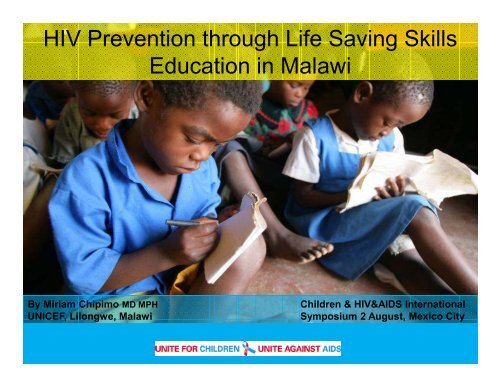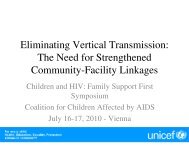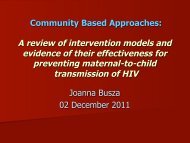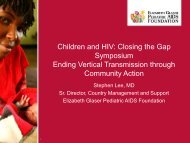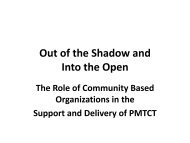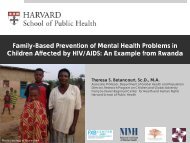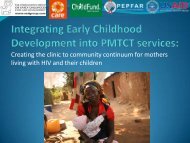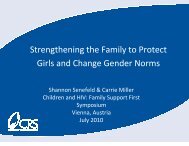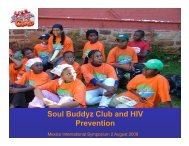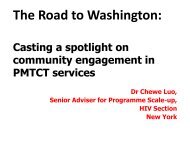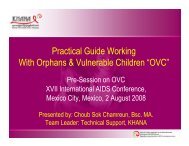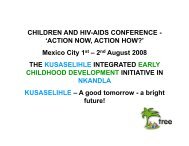HIV Prevention through Life Saving Skills Education in Malawi
HIV Prevention through Life Saving Skills Education in Malawi
HIV Prevention through Life Saving Skills Education in Malawi
Create successful ePaper yourself
Turn your PDF publications into a flip-book with our unique Google optimized e-Paper software.
<strong>HIV</strong> <strong>Prevention</strong> <strong>through</strong> <strong>Life</strong> <strong>Sav<strong>in</strong>g</strong> <strong>Skills</strong><br />
<strong>Education</strong> <strong>in</strong> <strong>Malawi</strong><br />
By Miriam Chipimo MD MPH<br />
UNICEF, Lilongwe, <strong>Malawi</strong><br />
Children & <strong>HIV</strong>&AIDS International<br />
Symposium 2 August, Mexico City
<strong>Malawi</strong> <strong>HIV</strong>&AIDS Situation at a glance<br />
Total population 12,884,000<br />
By end of 2007:<br />
<strong>HIV</strong> prevalence (15-49 years) 12.6 %<br />
New <strong>HIV</strong> <strong>in</strong>fections : 0-14 years 19,791<br />
15-24 years 65,027<br />
Persons liv<strong>in</strong>g with <strong>HIV</strong>: 0-14 years<br />
15-49 years<br />
89,055<br />
809,833<br />
Est. deaths from AIDS: 0-14 years 11,470<br />
15-49 years 48,161<br />
Est. no. of orphans: 0-17 years<br />
As a result of AIDS<br />
1,164,939<br />
436,503<br />
Est. no. <strong>in</strong> need of ART: 0-14 years 23,441<br />
15-49 years 252,720<br />
Patients ever started on ART 146,856 (53%)<br />
Est children <strong>in</strong> need of ART 23,000<br />
Children ever started on ART 11, 865 (31%)<br />
Number of ART deaths 16,780 (60% <strong>in</strong> 3m)
POLICY, PROGRAMMING & FUNDING ENVIRONMENT<br />
<br />
Existence of strong political will to fight <strong>HIV</strong>/AIDS<br />
A National AIDS Policy launched <strong>in</strong> 2004<br />
A National <strong>HIV</strong>/AIDS Action Framework 2005-2009<br />
<br />
<br />
<br />
<br />
for multi-sectoral response.<br />
Govt policies and guidel<strong>in</strong>es, and <strong>in</strong>stitutional<br />
frameworks for scaled up response are <strong>in</strong> place.<br />
A National Plan of Action for <strong>Prevention</strong> of <strong>HIV</strong>&AIDS<br />
is be<strong>in</strong>g implemented<br />
The National AIDS Commission provides<br />
leadership and overall policy coord<strong>in</strong>ation<br />
Global Funds $116m <strong>in</strong> 2007 - $32m is for prevention
Background on LSE<br />
<strong>Life</strong> <strong>Skills</strong> <strong>Education</strong> started <strong>in</strong> <strong>Malawi</strong> <strong>in</strong> 2002 funded by the Netherlands<br />
Government Multi Country LS Initiative (MCI)<br />
In 2005 <strong>Malawi</strong> had 3 384 500 pupils enrolled <strong>in</strong> schools:<br />
3,200, 646 were enrolled <strong>in</strong> 45,075 primary schools<br />
183 854 were enrolled <strong>in</strong> 978 secondary schools.<br />
Objectives of LSE were:<br />
To provide young people between 5 and 14 years with life skills to promote<br />
susta<strong>in</strong>ed <strong>HIV</strong> risk-reduction behaviour<br />
To enhance risk reduction among youth of 15 to 20 years <strong>through</strong><br />
promot<strong>in</strong>g abst<strong>in</strong>ence, delayed sexual activity and safe sex.<br />
The four components of the programme <strong>in</strong> <strong>Malawi</strong> were:<br />
1. In-school life skills education from Standards 1 to 5<br />
2. In-school extra-curricular Anti-AIDS clubs, with use of peer educators<br />
3. Promot<strong>in</strong>g an enabl<strong>in</strong>g environment by <strong>in</strong>volv<strong>in</strong>g parents and communities,<br />
and provid<strong>in</strong>g a radio programme and a youth newspaper<br />
4. Provid<strong>in</strong>g for effective management, monitor<strong>in</strong>g and evaluation.
Evaluation of MCI<br />
A multi-country evaluation of LSE was conducted <strong>in</strong><br />
2006 supported by UNICEF<br />
The evaluation used various methodologies to gather<br />
the data: desktop reviews; semi-structured <strong>in</strong>terviews;<br />
focus group discussions; and observation of life-skills<br />
lessons.<br />
Limitations:<br />
1. Severe time constra<strong>in</strong>ts<br />
2. Sampl<strong>in</strong>g was not random: 5/28 districts, 128<br />
students, 38 teachers, 3 parents, 16 policy level<br />
officials, 1 traditional leader
F<strong>in</strong>d<strong>in</strong>gs <strong>in</strong> <strong>Malawi</strong><br />
Young people showed:<br />
1. Good knowledge of <strong>HIV</strong>, <strong>in</strong>clud<strong>in</strong>g transmission,<br />
prevention and universal precautions.<br />
2. Awareness of gender-based violence and abuse where<br />
to report it.<br />
3. A positive attitude regard<strong>in</strong>g their ability to protect<br />
themselves aga<strong>in</strong>st <strong>HIV</strong>. With a tendancy to judge<br />
behaviour <strong>in</strong> categories of moral or immoral behaviour.<br />
4. An improvement <strong>in</strong> self-esteem<br />
5. Good levels of future orientation and were able to<br />
verbalise their dreams and future plans.<br />
6. Improved decision-mak<strong>in</strong>g skills, <strong>in</strong>creased ability to say<br />
no to unwanted sexual advances, better management of<br />
emotions, and a decl<strong>in</strong>e <strong>in</strong> physical fights on the<br />
playground.
F<strong>in</strong>d<strong>in</strong>gs<br />
1. Shortage of LS textbooks<br />
2. Five-day LS tra<strong>in</strong><strong>in</strong>g programme had been truncated <strong>in</strong>to a<br />
two-day programme<br />
3. Poor quality control <strong>in</strong> the cascade model of tra<strong>in</strong><strong>in</strong>g<br />
4. Teachers did not prioritise it as it was non exam<strong>in</strong>able<br />
5. Materials had been developed <strong>in</strong> the 1990s and needed<br />
updat<strong>in</strong>g.<br />
6. Susta<strong>in</strong>ability of fund<strong>in</strong>g for LS tra<strong>in</strong><strong>in</strong>g and materials<br />
7. Parents expressed discomfort about sexuality be<strong>in</strong>g<br />
<strong>in</strong>cluded <strong>in</strong> the programme. Parents had limited<br />
<strong>in</strong>volvement <strong>in</strong> the programme.<br />
8. Abst<strong>in</strong>ence-only focus. It provided little <strong>in</strong>formation about<br />
condoms. given evidence of sexual activity even at primaryschool<br />
level. However, youth centres seemed to show more<br />
flexibility <strong>in</strong> their sexuality education.
<strong>Life</strong> <strong>Sav<strong>in</strong>g</strong> <strong>Skills</strong> <strong>Education</strong> Evaluation<br />
2 nd evaluation of LSE <strong>in</strong> <strong>Malawi</strong> was conducted <strong>in</strong> 2007<br />
supported by UNFPA:<br />
Goal: To assess strengthen<strong>in</strong>g of capacity of<br />
education sector professional staff to implement<br />
LS/SRH/<strong>HIV</strong>/AIDS education <strong>in</strong> primary (standards 5-<br />
8) and secondary (Forms 1–4) schools.<br />
The evaluation used mixed methodologies to gather<br />
the data, <strong>in</strong>clud<strong>in</strong>g a desktop review of exist<strong>in</strong>g<br />
documents; semi-structured <strong>in</strong>terviews with key duty<br />
bearers; focus group discussions with learners,<br />
teachers, peer educators and members of EDZI Toto<br />
Clubs; and observation of life-skills lessons.<br />
Limitations were severe time constra<strong>in</strong>ts & sampl<strong>in</strong>g<br />
was not random
Methodology<br />
The study was carried out <strong>in</strong> 241 primary schools, 18<br />
secondary schools and 5 teacher-tra<strong>in</strong><strong>in</strong>g colleges<br />
<strong>through</strong>out the six education divisions.<br />
Data was collected from 4,150 students, 1,043 teachers,<br />
head teachers, education officials and parents.<br />
Self adm<strong>in</strong>istered questionnaires were used to assess<br />
knowledge and attitudes of pupils and students while<br />
focus group <strong>in</strong>terview guides were used to assess<br />
attitudes and practices of both students and pupils at<br />
different levels.<br />
Teachers represent<strong>in</strong>g Standards 5 to 8, forms 1 to 4<br />
and 2 from TTC completed a self adm<strong>in</strong>istered<br />
questionnaire assess<strong>in</strong>g their attitude to the subject, the<br />
impact of the subject on their lives and their perceptions<br />
about the impact of the subject on their pupils/students.
Key f<strong>in</strong>d<strong>in</strong>gs<br />
1. The level of knowledge of LS/SRH education<br />
concepts is comparatively low for primary<br />
school pupils and high for secondary school<br />
students.<br />
2. Primary schools have <strong>in</strong>adequate resources<br />
for the teach<strong>in</strong>g and learn<strong>in</strong>g of LS/SRH<br />
education. Primary schools that were <strong>in</strong>volved<br />
<strong>in</strong> the study did not have pupils’ books.<br />
3. Pupils <strong>in</strong> this study considered knowledge ga<strong>in</strong><br />
as the most important value of LS/SRH<br />
education.
Key f<strong>in</strong>d<strong>in</strong>gs<br />
4. The desire to change the behaviour of pupils<br />
and to reduce the spread of <strong>HIV</strong> and STIs as<br />
major goals of SRH/LS education were not<br />
viewed as key motivat<strong>in</strong>g factors by all<br />
respondents<br />
5. The majority of teachers (85%) <strong>in</strong>dicated that<br />
their schools supported the teach<strong>in</strong>g of<br />
LSE/SRH education.<br />
6. Pupils generally trust their teachers as people<br />
who should handle referral safe sex services at<br />
their schools.<br />
7. Safe sex referral services are very rare <strong>in</strong><br />
schools.
Teachers op<strong>in</strong>ion of pupils chang<strong>in</strong>g behaviour<br />
Fig 4.4 Extent of Chang<strong>in</strong>g Behaviour<br />
of Pupils<br />
Miss<strong>in</strong>g<br />
Not at all<br />
Very much<br />
Very Litltle<br />
somewhat
Access to health services<br />
90<br />
85<br />
80<br />
70<br />
60<br />
Percentage<br />
50<br />
40<br />
30<br />
20<br />
10<br />
0<br />
39<br />
37<br />
3<br />
27<br />
2<br />
12<br />
9<br />
5<br />
Headteachers<br />
Teachers<br />
Students<br />
VCT<br />
STI Treatment<br />
Access to<br />
condoms
<strong>HIV</strong> KNOWLEDGE & PRACTICES AMONG YOUNG PEOPLE<br />
15-24 YEARS<br />
Knowledge of <strong>HIV</strong> (DHS 2004) M: 98% F: 98%<br />
Knowledge of use of condoms for M: 72% F: 55%<br />
prevention DHS 2004)<br />
Knowledge of abst<strong>in</strong>ence for prevention M: 83% F: 69%<br />
Comprehensive knowledge of <strong>HIV</strong> M: 33% F: 31%<br />
prevention among young people 15-24 (DHS 2001)<br />
Sex by age 18 among 15-19 (DHS, 2004) M: 48% F: 57%<br />
Young people aged 15-24 who had sex M: 62% F: 13.9%<br />
with a casual partner <strong>in</strong> the previous 12 months<br />
Condom use at last high risk sex among M: 36% F: 35%<br />
young people 15-24<br />
Young people aged 15-24 tested for <strong>HIV</strong> M: 4.1% F:3.7%<br />
& received results<br />
Prevalence among pregnant women 12.3%<br />
15-24, (<strong>Malawi</strong> 2007 SS)<br />
Estimated prevalence among young M: 4% F:13%<br />
people 15-24 (UNAIDS, 2006)
Median <strong>HIV</strong> prevalence trends 1998 - 2007<br />
25<br />
20<br />
15<br />
%<br />
10<br />
5<br />
0<br />
1998 1999 2001 2003 2005 2007<br />
Year
<strong>HIV</strong> Prevalence by Age Among Pregnant Females<br />
2007 Sent<strong>in</strong>el Surveillance<br />
20.00%<br />
18.00%<br />
16.00%<br />
14.00%<br />
12.00%<br />
10.00%<br />
8.00%<br />
6.00%<br />
4.00%<br />
2.00%<br />
0.00%<br />
8.00%<br />
12.30%<br />
19.00%<br />
13.80%<br />
17.10% 15.30%<br />
11.30%<br />
Less th an 15<br />
15 - 19<br />
15 - 24<br />
20 - 24<br />
25 - 29<br />
40 - 44<br />
45+<br />
30 - 34<br />
35 - 39
GAPS<br />
• The key recommendations on FLE<br />
addressed only some of the key f<strong>in</strong>d<strong>in</strong>gs<br />
• Assessment was subjective: teachers<br />
op<strong>in</strong>ions on students behaviour change<br />
• L<strong>in</strong>kages between M<strong>in</strong>istry of <strong>Education</strong><br />
and M<strong>in</strong>istry of Health have not been<br />
evaluated (access to health services)<br />
• Data from national surveys not <strong>in</strong>cluded<br />
<strong>in</strong> evaluations
<strong>Prevention</strong> among young people<br />
Achievements<br />
2.5 million primary school children (standards 1 – 4)<br />
provided with <strong>Life</strong> <strong>Skills</strong> as part of <strong>HIV</strong> prevention<br />
(5,168 schools)<br />
Peer education <strong>through</strong> 4,320 school-based and<br />
2,000 out-of-school anti-AIDS clubs (Edzi Toto)<br />
Lessons for <strong>Life</strong> is taught <strong>in</strong> all 1,000 secondary<br />
schools<br />
On-go<strong>in</strong>g support to implement the NPA for<br />
<strong>Prevention</strong> among Young People (UNFPA,<br />
UNICEF,WHO)<br />
178 youth friendly health services <strong>in</strong> 15 /28<br />
districts
Recommendations<br />
1. Improved M&E of LSE to <strong>in</strong>clude data from<br />
national surveys<br />
2. Strengthen<strong>in</strong>g of l<strong>in</strong>kages between M<strong>in</strong>istry of<br />
<strong>Education</strong> and M<strong>in</strong>istry of Health policies and<br />
services<br />
3. Scale up of Youth Friendly Health services to<br />
all districts<br />
4. Peer education for secondary schools<br />
5. Inclusion of issues on children and adults<br />
liv<strong>in</strong>g positively with <strong>HIV</strong> <strong>in</strong> LSE<br />
6. Targeted <strong>in</strong>terventions for young people that<br />
are out of school
Thank you!


